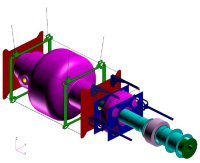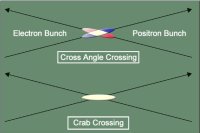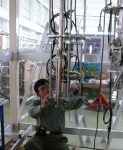 |
 |
|||||||||||||
|
|||||||||||||
|
|||||||||||||
|
What do superconducting cavities and the beach have in common? KEK accelerator physicists can give you the answer: the crab. During the spring operation period of the KEKB accelerator, scientists successfully achieved effective electron-positron collisions in a new cavity. Called the crab cavity, it tilts each bunch sideways so that the bunches collide head-on at the interaction point. This success will allow the KEKB to boost its luminosity, which is already the world’s highest for a B-factory, to an unprecedented level. Crab cavities will also play an important role in achieving high luminosities at other machines, including the International Linear Collider (ILC), upgrades for the Large Hadron Collider (LHC) at CERN, as well as future synchrotron light sources.
The concept of crab cavities was first suggested almost 30 years ago by Robert Palmer, who at the time was a scientist at SLAC, aiming to use them for linear electron-positron colliders. In 1989, KEK scientists, Katsunobu Oide and Kaoru Yokoya proposed the use of crab cavities in storage rings, and then Kazunori Akai developed the designs and prototype models as part of a collaboration between KEK and Cornell University. Earlier this year, the first full-size cavities were finally installed into the KEKB cryostat, and they were up and running from February to the end of last month. The typical bunches in the electron and positron beams have long and skinny structures of 2.1 micrometres high, 110 micrometres wide, and 7 millimetres long. The characteristics of these bunches, whose length is 65 times longer than its width, make it very difficult to gain a high rate of particle collisions at the collision point. The rate of collision, or luminosity, will be an extremely important measure of an accelerator's performance. At KEKB, the electron and positron beam bunches cross at an angle of 1.3 degrees. This crossing angle design is novel, providing effective beam separation at the collision point without a high level of background noise in the detector. However, the luminosity would be boosted further, if the bunches of electrons and positrons could be tilted sideways —the way a crab walks— so that they collide head-on at the interaction point. Accelerator scientists developed an idea to use the magnetic field in the cavity to tilt the beam bunches. When current flows in the magnetic field, it feels a force. (This is the same principle applied in an electric motor that converts electrical energy into mechanical energy.) The electron and positron beams also feel this force from the magnetic field. The electromagnetic field of the crab cavity is operated by a transverse mode, as opposed to the longitudinal mode in the normal acceleration cavities. A dipole magnetic field kicks the beam in the plane perpendicular to the beam direction. The result is the transverse offset or crab-walking of the electron and positron bunches to collide, face to face, at the collision point. In light of the recent achievement, KEK scientist Kenji Hosoyama, who led the detailed engineering and prototyping of the crab cavities, thought back along the 12-year road it took to reach this success. “One of the biggest challenges was the size of the cavity itself,” he says. “First, we produced a 'cute' version that was one-third of the size, and it ran quite well. So, we went ahead for the full scale prototype-it turned out to be much bigger than we had expected. Well, three times three in three dimensions means 27 times bigger in volume.” Small cavities can be carried by hand, but the cavity that measures 1 metre by .5 metre in cross section and 1.5 metres in length requires special equipment. The size issue also caused some difficulty in designing the cryostat, due to a large shrinkage of the cavity, once it is cooled down with liquid helium. Another big challenge was the limitation in funding. “The crab cavity has long been a low priority on the R&D list. So a lot of components and equipment, even the clean room to test the prototype cavity were 'handmade',” says Hosoyama. The situation changed three years ago, and R&D accelerated. “I really felt the pressure then. There was no test data on the crab cavities, and we did not have any forerunner to ask for guidance,” Hosoyama added. He had sleepless night after sleepless night while commissioning KEKB in fear of a late-night phone call reporting a malfunction, but to his relief, most of the calls turned out to be from his mother-in-law. Now he can sleep tight, as the crab cavities achieved a tune-shift comparable to the world record at low currents. Tune-shift is a quantity proportional to the luminosity divided by the product of beam currents — a measure of luminosity potential. Recently, at high beam currents (1300 mA (milliamps) in the low energy positron beam and 700 mA in the high energy electron beam), they were able to operate at a luminosity above 1034 cm2/sec. These results from the first round of commissioning demonstrate the potential of the crab cavities, which according to simulations may eventually improve the luminosity by a factor of two. The team will conduct more tests by trying different operational parameters. “The controlling technologies have already been established. I am pretty sure that more commissioning runs and R&D will enable a further increase in the performance. And if it proves successful, this technology will be a big help for future accelerators,” says Hosoyama. -- Rika Takahashi |
|||||||||||||
| © International Linear Collider |


